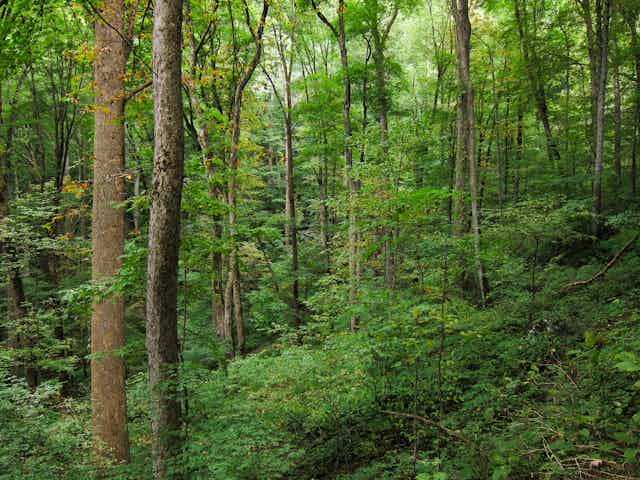The dip in atmospheric carbon dioxide levels during the Little Ice Age wasn’t caused by New World pioneers cutting a swathe through native American agriculture, as had been previously thought.
Instead, our new analysis of the climate record contained within Antarctic ice cores suggests that the fall in atmospheric CO₂ levels during the cold period from 1500 to 1750 was driven by increased net uptake of carbon by plants.
This in turn suggests that if plants reacted to falling temperatures by taking up more carbon, they are likely to react to the current rising CO₂ levels by releasing yet more of it into the atmosphere.
Historical atmospheres
Atmospheric CO₂ concentrations were fairly stable from around 2000 years ago until the start of the Industrial Revolution, since when they have begun to climb dramatically. However, along the way were relatively small shifts, such as that seen during the Little Ice Age (LIA).
Carbon dioxide naturally cycles between the atmosphere, the land and the ocean. On land, it is removed from the atmosphere by plant photosynthesis and returned when plant material decomposes. Normally these processes balance out, but a change in the rate of one of these processes can shift atmospheric CO₂ levels to a new equilibrium.
If decomposition increases as it warms, this will slow or reverse the rebalancing uptake, leaving more carbon dioxide in the atmosphere, warming the climate still further and so on, in a positive feedback.
The LIA corresponded with the start of European colonisation of the New World. European diseases devastated populations in the Americas, and one theory held that this led to a decrease in indigenous agriculture, which in turn let forests grow back and took up significant amounts of CO₂ from the atmosphere. This had been suggested as the first geologically recognisable signature of human impact on the globe, and thus the start of the Anthropocene epoch.
But was this actually the case? Our study suggests not, because while we can be relatively certain the LIA change in CO₂ levels was due to differences in the behaviour of land plants, our results suggest that the change was a response to the changing climate, and not to human-driven changes in vegetation cover.
Looking for clues
How can we tell? We know that the process involved terrestrial plants, because the atmosphere during the LIA was even lower in CO₂ containing the isotope carbon-12, which is preferred by photosynthesising plants.
But how do we know if the changes were due to changes in vegetation cover, or to climate feedbacks. To answer that we looked at another gas, carbonyl sulfide (COS), which is also trapped in air bubbles along with the carbon dioxide. This molecule has almost the same structure as CO₂, except one of the oxygen atoms is replaced with sulfur.
This is close enough to trick the plants, which take it up during photosynthesis. But unlike CO₂, COS it is not released when plant material decomposes so an increase in photosynthesis leads to a decrease in atmospheric COS.

This means that the “early Anthropocene” hypothesis has a testable consequence: it should have led to an observable reduction in COS concentrations within the ice cores. However, when we looked at the ice core record we found that there was an increase. This suggests that photosynthesis actually decreased during the LIA, rather than increasing as we would expect if the difference was due to forest regrowth.
This means that the drop in atmospheric CO₂ during the LIA was more likely to have been a direct response to the dipping temperatures. The cool climate of the LIA reduced photosynthesis but also slowed down plant respiration and decomposition, with the net effect that more CO₂ was taken up by the land biosphere during cool periods.
What about the future?

The flipside of this is that the reverse may happen when temperatures rise, as they are now. Rising temperatures are likely to mean even more CO₂ being released from the terrestrial biosphere. While plants continue to increase their photosynthesis as Earth warms, our findings suggest that plant decomposition will increase even more, meaning that less carbon stays in the soil.
This is concerning, because as we know, humans have opened the tap on a new source of carbon: fossil fuels that were previously locked away underground. We are rapidly returning lots of this stored carbon to the atmosphere, and the land and ocean are only removing about half of what we add.
Our discovery suggests that every degree increase in temperature will result in about 20 parts per million extra carbon dioxide in the atmosphere. This is about the middle of the expectation from climate models. It means that, if we want to keep global warming to within 2°C of average pre-industrial temperatures, in line with the Paris climate agreement, we need to factor in this positive feedback loop, which means that the more temperatures climb, the more extra CO₂ will be released from the world’s landscapes.

